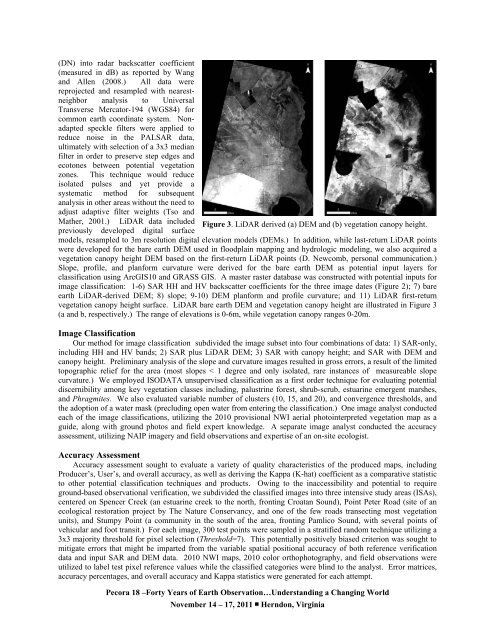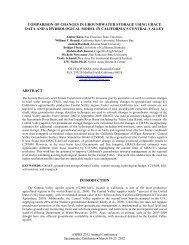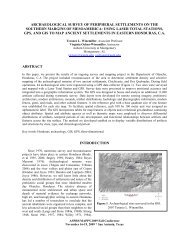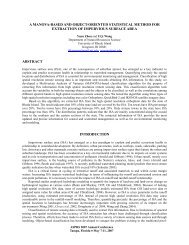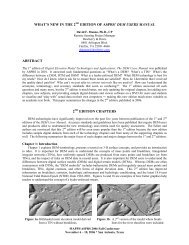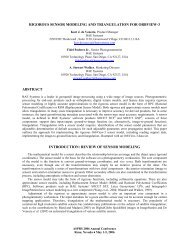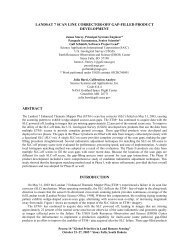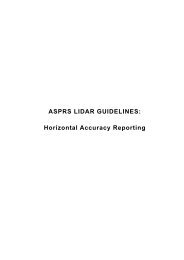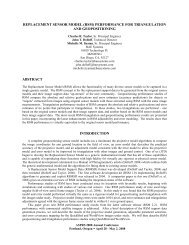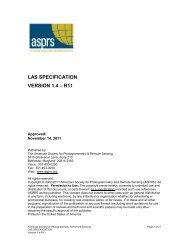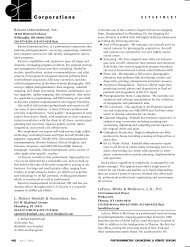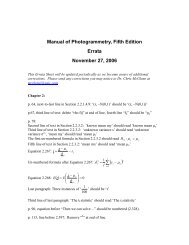coastal wetland mapping using time series sar imagery and ... - asprs
coastal wetland mapping using time series sar imagery and ... - asprs
coastal wetland mapping using time series sar imagery and ... - asprs
Create successful ePaper yourself
Turn your PDF publications into a flip-book with our unique Google optimized e-Paper software.
(DN) into radar backscatter coefficient<br />
(measured in dB) as reported by Wang<br />
<strong>and</strong> Allen (2008.) All data were<br />
reprojected <strong>and</strong> resampled with nearestneighbor<br />
analysis to Universal<br />
Transverse Mercator-194 (WGS84) for<br />
common earth coordinate system. Nonadapted<br />
speckle filters were applied to<br />
reduce noise in the PALSAR data,<br />
ultimately with selection of a 3x3 median<br />
filter in order to preserve step edges <strong>and</strong><br />
ecotones between potential vegetation<br />
zones. This technique would reduce<br />
isolated pulses <strong>and</strong> yet provide a<br />
systematic method for subsequent<br />
analysis in other areas without the need to<br />
adjust adaptive filter weights (Tso <strong>and</strong><br />
Mather, 2001.) LiDAR data included Figure 3. LiDAR derived (a) DEM <strong>and</strong> (b) vegetation canopy height.<br />
previously developed digital surface<br />
models, resampled to 3m resolution digital elevation models (DEMs.) In addition, while last-return LiDAR points<br />
were developed for the bare earth DEM used in floodplain <strong>mapping</strong> <strong>and</strong> hydrologic modeling, we also acquired a<br />
vegetation canopy height DEM based on the first-return LiDAR points (D. Newcomb, personal communication.)<br />
Slope, profile, <strong>and</strong> planform curvature were derived for the bare earth DEM as potential input layers for<br />
classification <strong>using</strong> ArcGIS10 <strong>and</strong> GRASS GIS. A master raster database was constructed with potential inputs for<br />
image classification: 1-6) SAR HH <strong>and</strong> HV backscatter coefficients for the three image dates (Figure 2); 7) bare<br />
earth LiDAR-derived DEM; 8) slope; 9-10) DEM planform <strong>and</strong> profile curvature; <strong>and</strong> 11) LiDAR first-return<br />
vegetation canopy height surface. LiDAR bare earth DEM <strong>and</strong> vegetation canopy height are illustrated in Figure 3<br />
(a <strong>and</strong> b, respectively.) The range of elevations is 0-6m, while vegetation canopy ranges 0-20m.<br />
Image Classification<br />
Our method for image classification subdivided the image subset into four combinations of data: 1) SAR-only,<br />
including HH <strong>and</strong> HV b<strong>and</strong>s; 2) SAR plus LiDAR DEM; 3) SAR with canopy height; <strong>and</strong> SAR with DEM <strong>and</strong><br />
canopy height. Preliminary analysis of the slope <strong>and</strong> curvature images resulted in gross errors, a result of the limited<br />
topographic relief for the area (most slopes < 1 degree <strong>and</strong> only isolated, rare instances of measureable slope<br />
curvature.) We employed ISODATA unsupervised classification as a first order technique for evaluating potential<br />
discernibility among key vegetation classes including, palustrine forest, shrub-scrub, estuarine emergent marshes,<br />
<strong>and</strong> Phragmites. We also evaluated variable number of clusters (10, 15, <strong>and</strong> 20), <strong>and</strong> convergence thresholds, <strong>and</strong><br />
the adoption of a water mask (precluding open water from entering the classification.) One image analyst conducted<br />
each of the image classifications, utilizing the 2010 provisional NWI aerial photointerpreted vegetation map as a<br />
guide, along with ground photos <strong>and</strong> field expert knowledge. A separate image analyst conducted the accuracy<br />
assessment, utilizing NAIP <strong>imagery</strong> <strong>and</strong> field observations <strong>and</strong> expertise of an on-site ecologist.<br />
Accuracy Assessment<br />
Accuracy assessment sought to evaluate a variety of quality characteristics of the produced maps, including<br />
Producer’s, User’s, <strong>and</strong> overall accuracy, as well as deriving the Kappa (K-hat) coefficient as a comparative statistic<br />
to other potential classification techniques <strong>and</strong> products. Owing to the inaccessibility <strong>and</strong> potential to require<br />
ground-based observational verification, we subdivided the classified images into three intensive study areas (ISAs),<br />
centered on Spencer Creek (an estuarine creek to the north, fronting Croatan Sound), Point Peter Road (site of an<br />
ecological restoration project by The Nature Conservancy, <strong>and</strong> one of the few roads transecting most vegetation<br />
units), <strong>and</strong> Stumpy Point (a community in the south of the area, fronting Pamlico Sound, with several points of<br />
vehicular <strong>and</strong> foot transit.) For each image, 300 test points were sampled in a stratified r<strong>and</strong>om technique utilizing a<br />
3x3 majority threshold for pixel selection (Threshold=7). This potentially positively biased criterion was sought to<br />
mitigate errors that might be imparted from the variable spatial positional accuracy of both reference verification<br />
data <strong>and</strong> input SAR <strong>and</strong> DEM data. 2010 NWI maps, 2010 color orthophotography, <strong>and</strong> field observations were<br />
utilized to label test pixel reference values while the classified categories were blind to the analyst. Error matrices,<br />
accuracy percentages, <strong>and</strong> overall accuracy <strong>and</strong> Kappa statistics were generated for each attempt.<br />
Pecora 18 –Forty Years of Earth Observation…Underst<strong>and</strong>ing a Changing World<br />
November 14 – 17, c 2011 ■ Herndon, Virginia d


